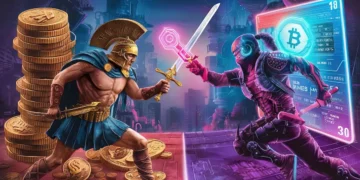If you’ve ever wondered what keeps a blockchain running without a central authority, the answer is simple: consensus algorithms, with the most famous one being proof-of-work. But what is proof-of-work?
This powerful consensus mechanism allows decentralized cryptocurrency networks to agree on valid blocks of transactions without trusting a single entity. Instead of a central server, PoW relies on computational power—lots of it. By competing to solve complex puzzles, network participants prove they’ve done the work and earn the right to add a new block. It’s the system that powers Bitcoin and helped launch the age of digital tokens.
What Is Proof-of-Work? PoW Explained
Proof-of-work (PoW) is a consensus mechanism used in blockchain networks. It secures transactions and prevents double spending. In PoW, computers solve complex mathematical problems. These problems require computing power. The first to solve the problem adds the next block to the blockchain. This system rewards the computer, or miner, that finds the solution first. The reward is usually cryptocurrency.
What cryptocurrencies use proof-of-work? You’ve definitely heard of them: after all, Bitcoin, the world’s biggest cryptocurrency, uses PoW to verify and record transactions. So does Litecoin, and many others. Ethereum used to use PoW, but it switched to proof-of-stake in 2022.
PoW ensures that adding blocks is hard, but verifying them is easy. This keeps the network decentralized and secure. Other consensus mechanisms, like proof-of-stake, work differently. They don’t rely on computing power but on the value of coins held, or “staked”, by participants.
PoW has been criticized for its high energy consumption: mining operations often use large amounts of electricity. For example, the Bitcoin network consumes about 185 terawatt-hours per year. That’s more than many small countries.
Despite the energy costs, PoW remains widely used due to its enhanced security and reliability.
The History of PoW
Although it isn’t an ancient development, the proof-of-work algorithm is not as young as many people probably expect it to be. Here’s a brief timeline of its key developments.
- 1993. PoW was first proposed by Cynthia Dwork and Moni Naor to deter spam.
- 1997. Adam Back introduced Hashcash, a PoW system used to limit email spam.
- 2004. Hal Finney expanded on Hashcash with reusable PoW tokens.
- 2008. Satoshi Nakamoto incorporated PoW in the Bitcoin whitepaper.
- 2009. Bitcoin launched using PoW to validate transactions.
- 2011–2013. Litecoin and other altcoins adopted PoW.
PoW has evolved from a tool against spam to the backbone of blockchain security.
Purpose of PoW in Blockchain Networks
Proof-of-work (PoW) replaces the need for a central authority. Instead of relying on banks or third parties, network participants verify transactions through mining. This makes the system decentralized and trustless.
On the Bitcoin blockchain, PoW ensures that only valid transactions are recorded. Miners compete using mining power to solve mathematical problems. This process is costly and time-consuming, which prevents spam and fraud. Proof-of-work blockchains can protect their networks by making attacks expensive. To rewrite the Bitcoin blockchain, an attacker would need to control over 50% of the total computing power. This is known as a 51% attack. The cost of such an attack, however, makes it unlikely.
For over a decade, PoW has kept Bitcoin and similar networks secure. It aligns incentives: miners are rewarded for acting honestly and punished for cheating. This self-regulating mechanism replaces centralized control with a system enforced by code and energy costs.
Network security in PoW systems depends on active, global participation. The more mining power in the network, the harder it is to compromise.
PoW is different from a stake system. In proof-of-stake, power comes from the number of coins you hold. In PoW, power comes from the computing resources you control.
How Does Proof-of-Work Work?
In a proof-of-work system, miners play a central role in keeping the blockchain secure and functional. Their job is to collect new, unconfirmed transactions and bundle them into a candidate block. To add this block to the blockchain, a miner must solve a cryptographic puzzle. The puzzle requires finding a specific hash—a long string of characters—that matches the network’s difficulty target. The only way to find the correct hash is by brute force: changing a value called a nonce and hashing the block’s data repeatedly until the result meets the target.
This process is competitive. Thousands of miners across the world race to find a valid hash. The more computing power—or mining power—a miner controls, the more likely they are to succeed. This competition is what secures the network.
When a miner finds the correct hash, they broadcast the solution to the rest of the network. Other nodes independently verify the block’s validity. If the transactions are valid and the hash meets the required difficulty, the block is added to the blockchain. This block then becomes a permanent part of the chain, linking back to the previous block by including its hash. This linking ensures that changing one block would require redoing all the work for every block that follows.
Miners are rewarded for their efforts through a block reward and transaction fees. For example, in the Bitcoin blockchain, each time a miner successfully adds a block, they—at the time of writing—receive 3.125 BTC as a reward, in addition to the transaction fees contained within the block. These incentives cover the costs of electricity and hardware, and they keep miners participating honestly in the network.

PoW and Blockchain Security
The strength of proof-of-work lies in its requirement for real-world resources. Unlike theoretical trust or digital staking, PoW demands electricity and hardware. This cost creates a built-in defense: launching an attack is not only difficult, but expensive and visible.
Security in PoW doesn’t rely on any single party. Instead, it emerges from global competition. Thousands of miners independently solve complex puzzles, making manipulation nearly impossible. As a result, PoW remains the most battle-tested consensus algorithm in blockchain—trusted by the Bitcoin network for over 15 years.
Advantages of the Proof-of-Work Consensus Algorithm
With the way it is presented in the media, it might sometimes seem that PoW is nothing but risks and disadvantages. While those are valid concerns and we will discuss them shortly, let’s take a look at what makes proof-of-work systems so popular even now when there are existing alternatives.
Proven security
The PoW consensus algorithm has secured the Bitcoin network since 2009 without a single major breach. Its track record shows resilience against fraud and double spending.
True decentralization
Anyone with internet access and Bitcoin mining equipment can participate. There’s no need for permission or ownership of coins, unlike in staking models.
Clear and fair competition
The mining process works like a global lottery system. Every miner has a chance to win, and success is based on computing effort, not wealth or status.
No reliance on identity or trust
PoW does not require validators to be known or trusted. The rules are enforced through code and energy, not reputation.
Incentive alignment
Miners are motivated to follow the rules. Honest mining leads to rewards; cheating leads to wasted resources.
Predictable block creation
PoW ensures blocks are added at a consistent rate by adjusting mining difficulty. This keeps the network stable even when mining power changes.
Become the smartest crypto enthusiast in the room
Get the top 50 crypto definitions you need to know in the industry for free

Disadvantages and Criticisms of PoW
Despite its strengths, the PoW consensus algorithm comes with several well-documented trade-offs. These concerns have driven research into alternative mechanisms like proof-of-stake. Below are the main criticisms PoW systems face today.
Energy usage
Proof-of-work consumes enormous amounts of electricity. This demand raises environmental concerns, especially when mining is powered by fossil fuels. While some operations use renewable energy, the overall footprint remains a major issue.
Scalability
PoW systems struggle with transaction throughput. This limitation is due to the time needed for miners to solve puzzles and the fixed block size. Scaling solutions like the Lightning Network exist, but base-layer scalability remains a challenge.
Centralization
Although PoW is designed to be decentralized, mining power is becoming concentrated. Large mining pools and farms dominate the hash rate—and this undermines the original idea of open participation and raises concerns about potential collusion or influence over network decisions.
Expensive Hardware Requirements
To mine competitively, you need specialized Bitcoin mining equipment like ASICs (application-specific integrated circuits). These machines are expensive, use a lot of power, and quickly become obsolete. This creates a high barrier to entry and favors well-funded operations over individual miners.
PoW vs. Alternative Consensus Mechanisms
Proof-of-work is not the only way to achieve consensus in a blockchain network. Over the years, developers have introduced several alternatives that aim to address PoW’s energy usage, scalability, and hardware requirements. Here’s how PoW compares to the most widely-used alternatives.

Proof-of-Stake (PoS)
PoS replaces mining power with coin ownership. Instead of solving puzzles, validators are chosen based on the amount of cryptocurrency they “stake”—or lock up—in the network. This significantly reduces energy consumption, since no intensive calculations are needed.
Ethereum transitioned from PoW to PoS in 2022, cutting its energy use by over 99%. However, PoS has its own risks. For example, wealth concentration can lead to centralization. Also, there’s ongoing debate about whether it can match PoW’s proven security in the long term.
Read more: Proof-of-Work vs. Proof-of-Stake: What Is The Difference?
Delegated PoS (DPoS)
DPoS is a variation of proof-of-stake. Instead of all stakers validating blocks, token holders vote to elect a small number of delegates. These delegates take turns adding new blocks. The system is fast and efficient, allowing high throughput.
Projects like EOS and TRON use DPoS. It performs well for large-scale applications but sacrifices some decentralization. A small number of validators can lead to cartel-like behavior and governance manipulation.
Proof-of-Authority (PoA)
PoA relies on a fixed set of trusted validators. These are usually pre-approved institutions or individuals. Because block production is controlled and predictable, PoA networks offer high speed and low energy use.
PoA is used in private or consortium blockchains, such as those built with Microsoft’s Azure Blockchain or VeChain. While efficient, PoA lacks the decentralization and censorship resistance that public PoW networks offer.
Notable Cryptocurrencies That Use Proof-of-Work
Even with newer consensus models gaining popularity, several major cryptocurrencies continue to rely on proof-of-work. These networks demonstrate how PoW can be adapted to different goals—from enhanced privacy to faster transactions. Each uses the algorithm in its own way, maintaining decentralization and securing the system through computing power.
Bitcoin (BTC): The Original PoW Chain
Bitcoin is the first and most valuable cryptocurrency using the proof-of-work model. Every Bitcoin transaction must be verified through the mining process, which secures the entire network. Miners use massive amounts of processing power to solve cryptographic puzzles and add new blocks to the chain. This system keeps Bitcoin decentralized and resistant to fraud, making it a core alternative investment in digital assets.
Read more: Is Bitcoin mining legal?
Litecoin (LTC): Quicker Blocks, Scrypt Algorithm
Litecoin was created as a faster version of Bitcoin. It uses the Scrypt hashing algorithm instead of SHA-256, making it more accessible to individual miners and slightly more resistant to ASIC dominance. Litecoin’s block time is 2.5 minutes, compared to Bitcoin’s 10 minutes, allowing for quicker transaction confirmations across the decentralized network.
Read more: How to Mine Litecoin: The Ultimate Guide to Litecoin Mining
Bitcoin Cash (BCH): Bitcoin Fork with Bigger Blocks
Bitcoin Cash is a fork of Bitcoin created to handle more transactions per block. It uses the same SHA-256 PoW algorithm, but with larger blocks to improve scalability. The goal was to make everyday use and microtransactions more practical while retaining the decentralized trust model secured by proof-of-work.
Monero (XMR): Privacy + ASIC-Resistance
Monero uses PoW but focuses on privacy and ASIC-resistance. Its mining algorithm, RandomX, is designed to favor CPUs over specialized Bitcoin mining equipment. This makes mining more accessible and reduces centralization. Monero also obscures sender, receiver, and transaction amounts, offering strong on-chain privacy not found in most other PoW cryptocurrencies.
Dogecoin (DOGE): Merged Mining with Litecoin
Dogecoin started as a joke but became a major PoW-based cryptocurrency. It uses the Scrypt algorithm and allows merged mining with Litecoin. This means miners can secure both networks at the same time using shared processing power. Dogecoin’s huge popularity and consistent updates have kept it relevant, especially as a meme-driven alternative investment.
H2 How Governments and Regulators View PoW
Governments and regulators worldwide are still on the fence when it comes to regulating PoW-based cryptocurrency networks. In the United States, the Securities and Exchange Commission (SEC) has clarified that certain PoW mining activities do not constitute securities offerings under federal law.
However, environmental concerns have prompted regulatory actions in some jurisdictions. For instance, in 2022, the New York State enacted a two-year moratorium on certain PoW cryptocurrency mining operations that rely on fossil fuels.
Internationally, discussions are underway about implementing climate taxes on energy-intensive industries, including cryptocurrency mining, to address environmental impacts.
The Future of PoW: Is It Sustainable Long-Term?
Proof-of-work (PoW) has secured cryptocurrency networks for over a decade. However, its sustainability is increasingly questioned due to high energy consumption. Some mining operations are transitioning to renewable energy sources, aiming to reduce their carbon footprint. However, the fundamental design of PoW remains energy-intensive.
Despite the downsides, PoW’s proven security and decentralization continue to make it a preferred choice for many cryptocurrency networks. The challenge lies in balancing environmental impact with the benefits that PoW offers.
While efforts are underway to make PoW more sustainable, its inherent energy-intensive nature poses significant challenges. The future of PoW will depend on the industry’s ability to innovate and adapt to environmental concerns while maintaining its core benefits.
FAQ
Why does proof-of-work require so much energy?
The proof-of-work consensus mechanism is intentionally energy-intensive. It relies on raw computational power to prevent fraud and secure the network. This means miners must run specialized hardware non-stop to solve mathematical problems and produce valid blocks. The more hash power in the network, the more secure—but also the more energy-hungry—it becomes.
Can anyone participate in proof-of-work mining?
Yes, anyone can mine as long as they have the hardware and internet access. PoW doesn’t require permission from a central authority. However, to compete effectively, you’ll need significant hash power—especially on major networks like Bitcoin, where mining has become highly competitive. For small players, joining a mining pool is often the only viable path.
Is proof-of-work really that harmful to the environment?
It can be, especially when powered by fossil fuels. The energy usage of PoW is a byproduct of its security model—more power means more protection. That said, some mining operations are now turning to renewable energy sources, and Bitcoin developers continue to explore ways to improve sustainability without compromising decentralization. Still, environmental impact remains a key criticism.
Can someone cheat the system and fake a block in PoW?
Not easily. The proof-of-work mechanism is designed to make cheating costly. To fake a block, a single entity would need to control over 50% of the network’s hash power—an attack that would require enormous resources. Even then, the network would likely notice and reject manipulated blocks.
Is it still profitable to mine cryptocurrencies using PoW in 2025?
It depends on what you’re mining, your electricity cost, and your equipment. Bitcoin mining can still be profitable with access to cheap energy and efficient hardware. However, competition is fierce, and rewards are halved regularly. For smaller players, other PoW coins with lower barriers to entry may offer better returns.
Read more: Most profitable coins to mine in 2025.
Why did Ethereum move away from proof-of-work?
Ethereum switched to proof-of-stake to reduce energy consumption and improve scalability. Under PoS, validators no longer need to solve puzzles—staking replaces computational work. This shift cut Ethereum’s energy use by over 99%.
Will proof-of-work disappear in the future?
No, PoW is unlikely to disappear anytime soon. Despite criticism, its simplicity, security, and lack of reliance on identity or reputation keep it relevant. Bitcoin, the world’s largest cryptocurrency, is still using it—and there’s no plan to change that. Unless a truly superior alternative proves itself, PoW will remain a pillar of decentralized finance.
Disclaimer: Please note that the contents of this article are not financial or investing advice. The information provided in this article is the author’s opinion only and should not be considered as offering trading or investing recommendations. We do not make any warranties about the completeness, reliability and accuracy of this information. The cryptocurrency market suffers from high volatility and occasional arbitrary movements. Any investor, trader, or regular crypto users should research multiple viewpoints and be familiar with all local regulations before committing to an investment.
If you’ve ever wondered what keeps a blockchain running without a central authority, the answer is simple: consensus algorithms, with the most famous one being proof-of-work. But what is proof-of-work?
This powerful consensus mechanism allows decentralized cryptocurrency networks to agree on valid blocks of transactions without trusting a single entity. Instead of a central server, PoW relies on computational power—lots of it. By competing to solve complex puzzles, network participants prove they’ve done the work and earn the right to add a new block. It’s the system that powers Bitcoin and helped launch the age of digital tokens.
What Is Proof-of-Work? PoW Explained
Proof-of-work (PoW) is a consensus mechanism used in blockchain networks. It secures transactions and prevents double spending. In PoW, computers solve complex mathematical problems. These problems require computing power. The first to solve the problem adds the next block to the blockchain. This system rewards the computer, or miner, that finds the solution first. The reward is usually cryptocurrency.
What cryptocurrencies use proof-of-work? You’ve definitely heard of them: after all, Bitcoin, the world’s biggest cryptocurrency, uses PoW to verify and record transactions. So does Litecoin, and many others. Ethereum used to use PoW, but it switched to proof-of-stake in 2022.
PoW ensures that adding blocks is hard, but verifying them is easy. This keeps the network decentralized and secure. Other consensus mechanisms, like proof-of-stake, work differently. They don’t rely on computing power but on the value of coins held, or “staked”, by participants.
PoW has been criticized for its high energy consumption: mining operations often use large amounts of electricity. For example, the Bitcoin network consumes about 185 terawatt-hours per year. That’s more than many small countries.
Despite the energy costs, PoW remains widely used due to its enhanced security and reliability.
The History of PoW
Although it isn’t an ancient development, the proof-of-work algorithm is not as young as many people probably expect it to be. Here’s a brief timeline of its key developments.
- 1993. PoW was first proposed by Cynthia Dwork and Moni Naor to deter spam.
- 1997. Adam Back introduced Hashcash, a PoW system used to limit email spam.
- 2004. Hal Finney expanded on Hashcash with reusable PoW tokens.
- 2008. Satoshi Nakamoto incorporated PoW in the Bitcoin whitepaper.
- 2009. Bitcoin launched using PoW to validate transactions.
- 2011–2013. Litecoin and other altcoins adopted PoW.
PoW has evolved from a tool against spam to the backbone of blockchain security.
Purpose of PoW in Blockchain Networks
Proof-of-work (PoW) replaces the need for a central authority. Instead of relying on banks or third parties, network participants verify transactions through mining. This makes the system decentralized and trustless.
On the Bitcoin blockchain, PoW ensures that only valid transactions are recorded. Miners compete using mining power to solve mathematical problems. This process is costly and time-consuming, which prevents spam and fraud. Proof-of-work blockchains can protect their networks by making attacks expensive. To rewrite the Bitcoin blockchain, an attacker would need to control over 50% of the total computing power. This is known as a 51% attack. The cost of such an attack, however, makes it unlikely.
For over a decade, PoW has kept Bitcoin and similar networks secure. It aligns incentives: miners are rewarded for acting honestly and punished for cheating. This self-regulating mechanism replaces centralized control with a system enforced by code and energy costs.
Network security in PoW systems depends on active, global participation. The more mining power in the network, the harder it is to compromise.
PoW is different from a stake system. In proof-of-stake, power comes from the number of coins you hold. In PoW, power comes from the computing resources you control.
How Does Proof-of-Work Work?
In a proof-of-work system, miners play a central role in keeping the blockchain secure and functional. Their job is to collect new, unconfirmed transactions and bundle them into a candidate block. To add this block to the blockchain, a miner must solve a cryptographic puzzle. The puzzle requires finding a specific hash—a long string of characters—that matches the network’s difficulty target. The only way to find the correct hash is by brute force: changing a value called a nonce and hashing the block’s data repeatedly until the result meets the target.
This process is competitive. Thousands of miners across the world race to find a valid hash. The more computing power—or mining power—a miner controls, the more likely they are to succeed. This competition is what secures the network.
When a miner finds the correct hash, they broadcast the solution to the rest of the network. Other nodes independently verify the block’s validity. If the transactions are valid and the hash meets the required difficulty, the block is added to the blockchain. This block then becomes a permanent part of the chain, linking back to the previous block by including its hash. This linking ensures that changing one block would require redoing all the work for every block that follows.
Miners are rewarded for their efforts through a block reward and transaction fees. For example, in the Bitcoin blockchain, each time a miner successfully adds a block, they—at the time of writing—receive 3.125 BTC as a reward, in addition to the transaction fees contained within the block. These incentives cover the costs of electricity and hardware, and they keep miners participating honestly in the network.

PoW and Blockchain Security
The strength of proof-of-work lies in its requirement for real-world resources. Unlike theoretical trust or digital staking, PoW demands electricity and hardware. This cost creates a built-in defense: launching an attack is not only difficult, but expensive and visible.
Security in PoW doesn’t rely on any single party. Instead, it emerges from global competition. Thousands of miners independently solve complex puzzles, making manipulation nearly impossible. As a result, PoW remains the most battle-tested consensus algorithm in blockchain—trusted by the Bitcoin network for over 15 years.
Advantages of the Proof-of-Work Consensus Algorithm
With the way it is presented in the media, it might sometimes seem that PoW is nothing but risks and disadvantages. While those are valid concerns and we will discuss them shortly, let’s take a look at what makes proof-of-work systems so popular even now when there are existing alternatives.
Proven security
The PoW consensus algorithm has secured the Bitcoin network since 2009 without a single major breach. Its track record shows resilience against fraud and double spending.
True decentralization
Anyone with internet access and Bitcoin mining equipment can participate. There’s no need for permission or ownership of coins, unlike in staking models.
Clear and fair competition
The mining process works like a global lottery system. Every miner has a chance to win, and success is based on computing effort, not wealth or status.
No reliance on identity or trust
PoW does not require validators to be known or trusted. The rules are enforced through code and energy, not reputation.
Incentive alignment
Miners are motivated to follow the rules. Honest mining leads to rewards; cheating leads to wasted resources.
Predictable block creation
PoW ensures blocks are added at a consistent rate by adjusting mining difficulty. This keeps the network stable even when mining power changes.
Become the smartest crypto enthusiast in the room
Get the top 50 crypto definitions you need to know in the industry for free

Disadvantages and Criticisms of PoW
Despite its strengths, the PoW consensus algorithm comes with several well-documented trade-offs. These concerns have driven research into alternative mechanisms like proof-of-stake. Below are the main criticisms PoW systems face today.
Energy usage
Proof-of-work consumes enormous amounts of electricity. This demand raises environmental concerns, especially when mining is powered by fossil fuels. While some operations use renewable energy, the overall footprint remains a major issue.
Scalability
PoW systems struggle with transaction throughput. This limitation is due to the time needed for miners to solve puzzles and the fixed block size. Scaling solutions like the Lightning Network exist, but base-layer scalability remains a challenge.
Centralization
Although PoW is designed to be decentralized, mining power is becoming concentrated. Large mining pools and farms dominate the hash rate—and this undermines the original idea of open participation and raises concerns about potential collusion or influence over network decisions.
Expensive Hardware Requirements
To mine competitively, you need specialized Bitcoin mining equipment like ASICs (application-specific integrated circuits). These machines are expensive, use a lot of power, and quickly become obsolete. This creates a high barrier to entry and favors well-funded operations over individual miners.
PoW vs. Alternative Consensus Mechanisms
Proof-of-work is not the only way to achieve consensus in a blockchain network. Over the years, developers have introduced several alternatives that aim to address PoW’s energy usage, scalability, and hardware requirements. Here’s how PoW compares to the most widely-used alternatives.

Proof-of-Stake (PoS)
PoS replaces mining power with coin ownership. Instead of solving puzzles, validators are chosen based on the amount of cryptocurrency they “stake”—or lock up—in the network. This significantly reduces energy consumption, since no intensive calculations are needed.
Ethereum transitioned from PoW to PoS in 2022, cutting its energy use by over 99%. However, PoS has its own risks. For example, wealth concentration can lead to centralization. Also, there’s ongoing debate about whether it can match PoW’s proven security in the long term.
Read more: Proof-of-Work vs. Proof-of-Stake: What Is The Difference?
Delegated PoS (DPoS)
DPoS is a variation of proof-of-stake. Instead of all stakers validating blocks, token holders vote to elect a small number of delegates. These delegates take turns adding new blocks. The system is fast and efficient, allowing high throughput.
Projects like EOS and TRON use DPoS. It performs well for large-scale applications but sacrifices some decentralization. A small number of validators can lead to cartel-like behavior and governance manipulation.
Proof-of-Authority (PoA)
PoA relies on a fixed set of trusted validators. These are usually pre-approved institutions or individuals. Because block production is controlled and predictable, PoA networks offer high speed and low energy use.
PoA is used in private or consortium blockchains, such as those built with Microsoft’s Azure Blockchain or VeChain. While efficient, PoA lacks the decentralization and censorship resistance that public PoW networks offer.
Notable Cryptocurrencies That Use Proof-of-Work
Even with newer consensus models gaining popularity, several major cryptocurrencies continue to rely on proof-of-work. These networks demonstrate how PoW can be adapted to different goals—from enhanced privacy to faster transactions. Each uses the algorithm in its own way, maintaining decentralization and securing the system through computing power.
Bitcoin (BTC): The Original PoW Chain
Bitcoin is the first and most valuable cryptocurrency using the proof-of-work model. Every Bitcoin transaction must be verified through the mining process, which secures the entire network. Miners use massive amounts of processing power to solve cryptographic puzzles and add new blocks to the chain. This system keeps Bitcoin decentralized and resistant to fraud, making it a core alternative investment in digital assets.
Read more: Is Bitcoin mining legal?
Litecoin (LTC): Quicker Blocks, Scrypt Algorithm
Litecoin was created as a faster version of Bitcoin. It uses the Scrypt hashing algorithm instead of SHA-256, making it more accessible to individual miners and slightly more resistant to ASIC dominance. Litecoin’s block time is 2.5 minutes, compared to Bitcoin’s 10 minutes, allowing for quicker transaction confirmations across the decentralized network.
Read more: How to Mine Litecoin: The Ultimate Guide to Litecoin Mining
Bitcoin Cash (BCH): Bitcoin Fork with Bigger Blocks
Bitcoin Cash is a fork of Bitcoin created to handle more transactions per block. It uses the same SHA-256 PoW algorithm, but with larger blocks to improve scalability. The goal was to make everyday use and microtransactions more practical while retaining the decentralized trust model secured by proof-of-work.
Monero (XMR): Privacy + ASIC-Resistance
Monero uses PoW but focuses on privacy and ASIC-resistance. Its mining algorithm, RandomX, is designed to favor CPUs over specialized Bitcoin mining equipment. This makes mining more accessible and reduces centralization. Monero also obscures sender, receiver, and transaction amounts, offering strong on-chain privacy not found in most other PoW cryptocurrencies.
Dogecoin (DOGE): Merged Mining with Litecoin
Dogecoin started as a joke but became a major PoW-based cryptocurrency. It uses the Scrypt algorithm and allows merged mining with Litecoin. This means miners can secure both networks at the same time using shared processing power. Dogecoin’s huge popularity and consistent updates have kept it relevant, especially as a meme-driven alternative investment.
H2 How Governments and Regulators View PoW
Governments and regulators worldwide are still on the fence when it comes to regulating PoW-based cryptocurrency networks. In the United States, the Securities and Exchange Commission (SEC) has clarified that certain PoW mining activities do not constitute securities offerings under federal law.
However, environmental concerns have prompted regulatory actions in some jurisdictions. For instance, in 2022, the New York State enacted a two-year moratorium on certain PoW cryptocurrency mining operations that rely on fossil fuels.
Internationally, discussions are underway about implementing climate taxes on energy-intensive industries, including cryptocurrency mining, to address environmental impacts.
The Future of PoW: Is It Sustainable Long-Term?
Proof-of-work (PoW) has secured cryptocurrency networks for over a decade. However, its sustainability is increasingly questioned due to high energy consumption. Some mining operations are transitioning to renewable energy sources, aiming to reduce their carbon footprint. However, the fundamental design of PoW remains energy-intensive.
Despite the downsides, PoW’s proven security and decentralization continue to make it a preferred choice for many cryptocurrency networks. The challenge lies in balancing environmental impact with the benefits that PoW offers.
While efforts are underway to make PoW more sustainable, its inherent energy-intensive nature poses significant challenges. The future of PoW will depend on the industry’s ability to innovate and adapt to environmental concerns while maintaining its core benefits.
FAQ
Why does proof-of-work require so much energy?
The proof-of-work consensus mechanism is intentionally energy-intensive. It relies on raw computational power to prevent fraud and secure the network. This means miners must run specialized hardware non-stop to solve mathematical problems and produce valid blocks. The more hash power in the network, the more secure—but also the more energy-hungry—it becomes.
Can anyone participate in proof-of-work mining?
Yes, anyone can mine as long as they have the hardware and internet access. PoW doesn’t require permission from a central authority. However, to compete effectively, you’ll need significant hash power—especially on major networks like Bitcoin, where mining has become highly competitive. For small players, joining a mining pool is often the only viable path.
Is proof-of-work really that harmful to the environment?
It can be, especially when powered by fossil fuels. The energy usage of PoW is a byproduct of its security model—more power means more protection. That said, some mining operations are now turning to renewable energy sources, and Bitcoin developers continue to explore ways to improve sustainability without compromising decentralization. Still, environmental impact remains a key criticism.
Can someone cheat the system and fake a block in PoW?
Not easily. The proof-of-work mechanism is designed to make cheating costly. To fake a block, a single entity would need to control over 50% of the network’s hash power—an attack that would require enormous resources. Even then, the network would likely notice and reject manipulated blocks.
Is it still profitable to mine cryptocurrencies using PoW in 2025?
It depends on what you’re mining, your electricity cost, and your equipment. Bitcoin mining can still be profitable with access to cheap energy and efficient hardware. However, competition is fierce, and rewards are halved regularly. For smaller players, other PoW coins with lower barriers to entry may offer better returns.
Read more: Most profitable coins to mine in 2025.
Why did Ethereum move away from proof-of-work?
Ethereum switched to proof-of-stake to reduce energy consumption and improve scalability. Under PoS, validators no longer need to solve puzzles—staking replaces computational work. This shift cut Ethereum’s energy use by over 99%.
Will proof-of-work disappear in the future?
No, PoW is unlikely to disappear anytime soon. Despite criticism, its simplicity, security, and lack of reliance on identity or reputation keep it relevant. Bitcoin, the world’s largest cryptocurrency, is still using it—and there’s no plan to change that. Unless a truly superior alternative proves itself, PoW will remain a pillar of decentralized finance.
Disclaimer: Please note that the contents of this article are not financial or investing advice. The information provided in this article is the author’s opinion only and should not be considered as offering trading or investing recommendations. We do not make any warranties about the completeness, reliability and accuracy of this information. The cryptocurrency market suffers from high volatility and occasional arbitrary movements. Any investor, trader, or regular crypto users should research multiple viewpoints and be familiar with all local regulations before committing to an investment.





















































































clomiphene cost clomid generic where to get cheap clomid price can you buy generic clomid without insurance clomiphene for men can i buy generic clomid how to buy clomiphene pill
I couldn’t turn down commenting. Profoundly written!
Thanks for sharing. It’s top quality.
buy azithromycin for sale – sumycin uk metronidazole ca
buy rybelsus pill – purchase semaglutide for sale how to get cyproheptadine without a prescription
buy augmentin paypal – at bio info buy acillin tablets
how to buy nexium – anexa mate esomeprazole where to buy
coumadin tablet – coumamide buy cheap losartan
cost meloxicam 15mg – moboxsin.com buy meloxicam 7.5mg online cheap
prednisone 5mg uk – https://apreplson.com/ prednisone 5mg generic
generic ed pills – buy ed pills no prescription best over the counter ed pills
amoxil buy online – https://combamoxi.com/ amoxil buy online
buy fluconazole without a prescription – https://gpdifluca.com/ buy cheap fluconazole
generic escitalopram 20mg – anxiety pro buy generic lexapro over the counter
cenforce 100mg price – on this site cenforce 50mg cost
buy cialis generic online 10 mg – cialis sublingual where can i buy cialis over the counter
cialis for daily use – https://strongtadafl.com/# cialis effect on blood pressure
zantac cheap – click buy cheap zantac
viagra 50 mg price walmart – click order viagra plus
The thoroughness in this piece is noteworthy. https://gnolvade.com/
The depth in this tune is exceptional. furosemide medication
I am actually enchant‚e ‘ to glitter at this blog posts which consists of tons of of use facts, thanks object of providing such data. https://ursxdol.com/prednisone-5mg-tablets/
With thanks. Loads of erudition! https://prohnrg.com/
With thanks. Loads of knowledge! pharmacie qui vend du cialis super active sans ordonnance
Proof blog you have here.. It’s intricate to find elevated calibre belles-lettres like yours these days. I truly comprehend individuals like you! Withstand guardianship!! https://ondactone.com/spironolactone/
Thanks an eye to sharing. It’s top quality.
https://doxycyclinege.com/pro/spironolactone/
More posts like this would bring about the blogosphere more useful. http://mi.minfish.com/home.php?mod=space&uid=1412626
purchase dapagliflozin online cheap – order dapagliflozin 10mg for sale buy generic forxiga
buy orlistat cheap – site orlistat 120mg usa
This website positively has all of the information and facts I needed to this case and didn’t identify who to ask. https://sportavesti.ru/forums/users/fqdde-2/